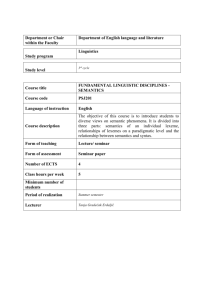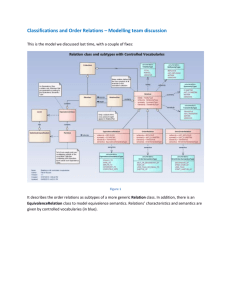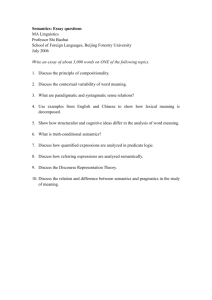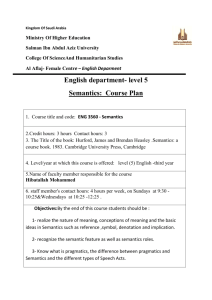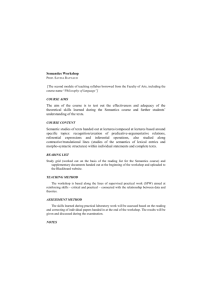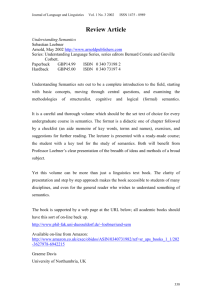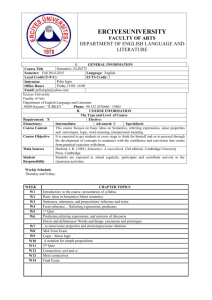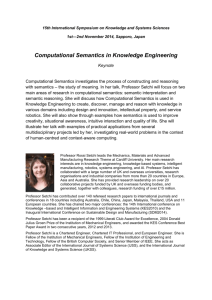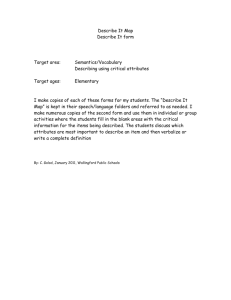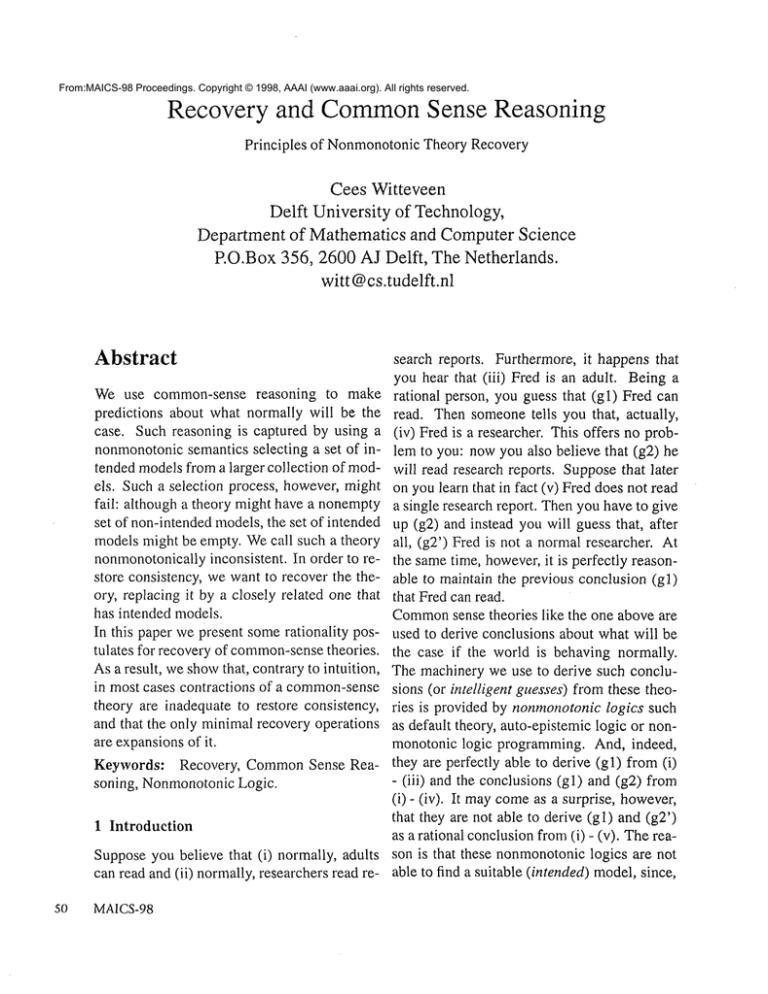
From:MAICS-98 Proceedings. Copyright © 1998, AAAI (www.aaai.org). All rights reserved.
Recovery and Common
Sense Reasoning
Principles of NonmonotonicTheory Recovery
Cees Witteveen
Delft University of Technology,
Departmentof Mathematicsand ComputerScience
EO.Box356, 2600 AJ Delft, The Netherlands.
witt @cs.tudelft.nl
Abstract
search reports. Furthermore, it happens that
you hear that (iii) Fred is an adult. Being
We use common-sense reasoning to make rational person, you guess that (gl) Fred can
predictions about what normally will be the read. Thensomeonetells you that, actually,
case. Such reasoning is captured by using a (iv) Fred is a researcher. This offers no probnonmonotonicsemantics selecting a set of in- lem to you: nowyou also believe that (g2)
tended modelsfrom a larger collection of mod- will read research reports. Supposethat later
els. Such a selection process, however, might on you learn that in fact (v) Fred does not read
fail: although a theory might have a nonempty a single research report. Thenyouhave to give
set of non-intendedmodels,the set of intended up (g2) and instead you will guess that, after
modelsmight be empty. Wecall such a theory all, (g2’) Fred is not a normalresearcher.
nonmonotonicallyinconsistent. In order to re- the sametime, however,it is perfectly reasonstore consistency, we want to recover the the- able to maintain the previous conclusion (gl)
ory, replacing it by a closely related one that that Fredcan read.
has intended models.
Common
sense theories like the one above are
In this paper wepresent somerationality pos- used to derive conclusions about what will be
tulates for recovery of common-sense
theories. the case if the world is behaving normally.
As a result, weshowthat, contrary to intuition, The machinerywe use to derive such concluin most cases contractions of a common-sensesions (or intelligent guesses) fromthese theotheory are inadequate to restore consistency, ries is provided by nonmonotoniclogics such
and that the only minimalrecovery operations as default theory, auto-epistemiclogic or nonare expansionsof it.
monotonic logic programming. And, indeed,
Keywords" Recovery, CommonSense Rea- they are perfectly able to derive (gl) from (i)
- (iii) and the conclusions (gl) and (g2)
soning, NonmonotonicLogic.
(i) - (iv). It maycomeas a surprise, however,
that they are not able to derive (gl) and (g2’)
1 Introduction
as a rational conclusionfrom(i) - (v). The
Supposeyou believe that (i) normally, adults son is that these nonmonotoniclogics are not
can read and (ii) normally,researchers read re- able to find a suitable (intended) model,since,
5o MAICS-98
expecting the world to be a normal one, no in- models for a common sense theory T, even
if T itself has other (non-intended) models.
tended model can be found where besides (i)
- (iv), (v) also holds. So according to these In this case, T is called nonmonotonically inlogics, the theory consisting of the statements consistent (nm-inconsistent). For example, the
theory consisting of the statements (i)- (v)
(i) - (v) non-monotonically inc onsistent (nm
inconsistent) and does not make sense if the inconsistent under a default-theory interpretation.
world is as normal as we expected it to be.
For
an nm-inconsistent theory it may happen
Theory Recovery
The problem howto interpret a theory that, ac- that both a theory T’ containing T and a the1.
cording to some semantics Sere, does not have ory T" contained in T have intended models
an acceptable meaning, constitutes a theory Therefore, in contrast to recovery of classical
theories, not only contraction, but also expanrecovery problem: given a Sere-inconsistent
sion or a mixture of both operations, in princitheory T, how do we construct a reasonable
alternative T’ to T such that (i) T’ is Sere- ple, might be used to recover a nonmonotonic
z.
theory
consistent and (ii) the information content
It comesas no surprise that in the existing litT’ resembles T as much as possible.
If Sere is a classical semantics, there is a well- erature of nonmonotonic theory recovery, one
known framework for theory recovery: the can find proposals for theory contraction (e.g.
[5]), for theory expansion (see [1, 6]) as well
AGM-framework
for theory-revision (see [2]).
Since a classically inconsistent theory does not as a mixture of expansion and contraction to
have any model at all, it comes as no sur- restore the consistency of such a theory (e.g.
prise that the proposed recovery operation is [3]).
a contraction of the original theory T. That is, In all these proposals however, we do not find
a reasonable alternative T’ is obtained by re- a justification for using a particular recovery
moving some information from T. The AGM-. operation. Therefore, the goal of this paper is
rationality postulates for recovery ensure that to give a principled approach to theory recovthe information loss by contracting T is mini- ery by offering a framework for recovery with
mized with respect to an underlying preference nonstandard semantics. We will show that, in
relation, the entrenchment relation. This re- particular for nonmonotonic theory recovery,
lation is used to capture the commitmentof a only recovery by expansion is suitable as a rerational agent to the information contained in covery operation. Due to lack of space, all
the theory: roughly the idea is that the deeper proofs of results have been omitted (but, see
some information is entrenched in the belief [8] for proofs of results).
structure of the agent, the more reluctant the
agent will be to give it up.
Recovery and nonmonotonic semantics
If a nonmonotonic semantics is used, it is
not evident that the AGM-approach can be
applied. For, using a nonmonotic semantics
means that only a subset of some larger collection of models of the theory is selected as
constituting the preferred or intended models
of the theory. Such a nonmonotonic semantics, however, might fail to provide intended
Our approach
With an intended nonmonotonic semantics Int
1For example,if T is the nm-inconsistenttheory
consistingof the statements(i) - (v), the theoryT’
sultingfromaddingthe fact that (vi) Fredis not a normal
researcherwill haveintendedmodelsundera default semantics.Andalso doesthe theoryT" consistingof (i)
(iv).
2Thisalso impliesthat the notionof an entrenchment
relation maynot be a useful conceptto use in nonmonotonic theories, since it is preparedfor recoveryby contractionstrategies
Witteveen
51
to reason about a theory T, a subset of mod- give us someclues about which abnormalities
els, the intended models, is selected from some we have to be prepared for. Wemayconsider
given collection of models for T. These in- the modelsselected by such an S as a first aptended models are useful for making predic- proximation of the set of intended modelsof
tions about a normal world. Sometimes, how- the theory modulothe apparent abnormalities.
ever, the world is not as normalas we think it So, given someInt-inconsistent theory T, what
is. In such apparently abnormalcircumstances about theories T’ that have the same maxiweshould not be surprised to find out that in- mal background models as T has? It seems
tended models of a theory T cannot be used to be reasonable to consider them as theories
to give a satisfactory description. So we do closely resembling T. Amongsuch theories
not consider Int to be defective: it is perfectly there might be a theory T’ such that T’ does
possible that there exist intended models for have intended models. Such a theory T~ might
T modulothe abnormalities detected. That is, be consideredas a syntactical reformulationof
if somehowwe take into account these appar- T that comesas close to its original meaning
ent abnormalities, we might be able to use our as possible.
intended semantics. To be able to do so, we Hence,we decide to recover the original thewill try to represent such abnormalities syn- ory T by applying a transformation t~ to T
tactically, by modifyingthe current theory T. such that (i) /~(T) Int -consistent and(ii)
Wetherefore adhere to the principle change T and/~(T) are indistinguishable under BCK.
the theory and not the logic to reason with. This guarantees that we do not allow for more
So what we are looking for is a recovery T’ abnormalities to occur than is necessary.
of T, such that T’ does have intended models Remark. Notice that the use of a maximal
and resembles T. It should resemble T in that backgroundsemantics also guarantees the exthese intended modelsare the intended models istence of a lower bound on the informaof the original theory T modulothe abnormal- tion loss associated with the recovery process:
ities observed. But howdo we obtain such a since the intended models of /~(T) are intheory T’? To this end we use a class BCK cluded in the backgroundmodels of R(T) and
of backgroundsemantics. This class is used these are equal to the backgroundmodelsof T,
to fall back on weaker3 interpretations of the wekeep at least as muchinformation as can be
theory whenInt fails to provide an interpre- obtained from the backgroundsemantics.
tation. Using a semantics 5’ E BCKwe are Organisationof the paper
able to select somenon-intended models of T Wewill develop a formal frameworkfor recovthat take into account someabnormalities. Of ery based on these intuitive ideas. Before we
course we want to include as few abnormali- present this framework,wefirst discuss some
ties as seems to be necessary. Therefore, we necessary preliminaries, needed to understand
prefer those semantics S in BCKthat comeas the formal details. Ourmainquestion is: given
close to the intended semantics lnt as possible this framework,whichtype of recovery operaand, moreover, are able to provide a meaning tions are adequate to deal with nonmonotonic
to T. Let us call such a semantics a maximal theory recovery. By giving a general charbackgroundsemantics. Since a maximalback- acterization of nonmonotonictheories we are
ground semantics S is weakerthan Int, it al- able to showthat under very general conditions
lows for moreabnormalities to occur and may contraction can be excluded and, if we want
to changethe theory as little as possible, we
3For they allow more abnormalities to occur and should expandour theory.
therefore can predict less.
52
MAICS-98
2 Preliminaries
properties a suitable recovery operator should
have. These properties partly dependon some
Given a language L, a theory T is any subset abstract properties of the consequenceoperaof L. Weassume to have a way to assign to tors used. Therefore we recall (see e.g. [4])
each T some (possibly empty) set of models some general properties along which one can
Mod(T)in somespecified class. For any class classify consequence operators: A C_ C(A)
of theories T a semantics Sera then is a way (Inclusion), C( A) = C( C( A ) ) (Idempotency),
to associate consequences ~ to some T E "T, A C B implies C(A) C C(B)(Monotony),
based on Mod(T). Such a semantics is called A c_ B c_ C(A) implies C(B) c_ C(A) (Cut)
well-behavedw.r.t. T if Sere(T) is defined and andA C B C_ C(A) impliesC(A) c_
is not equal to L. Weoften identify a seman- (Cautious Monotony).
tics Sere with a consequenceoperation Cs~.~ : A classical inference operation C will also be
2L -+ 2L, where the set Cs~m(T)denotes the denoted by Cn. An inference operation C is
set of valid conclusions obtainable from T us- called Tarskian
4 if it satisfies Inclusion, Ideming the semantics Sern. In this paper, we stip- potency and Monotony,and it satisfies Cumuulate that Cs~,~(T) = incase Sere(T) is not
lativity if both Cut and Cautious Monotony
defined. Generalizing the above, we say that a hold for C. Finally, C is called a cumulative
consequenceoperator C is well-behavedw.r.t. inferenceoperation, if it satisfies Inclusionand
T, if C(T) ~ L. Wefocus theories that have Cumulativity.
morethan one semantics. Besides our intended As we have shownin [7, 8], we need the folsemantics Int characterized by an associated lowing weaker variants of Cut and Cautious
consequenceoperator Ci,~t, we consider a class Monotonyto distinguish non-monotoniclogics
of background semantics BCKfor Ci,~t. The from other non-standardlogics:
class BCKis characterized by a correspond- A C_ B C_ C(A)and C(A) ~¢ implies
ing class CBCKof consequenceoperators Cbck C(B) ¢ L (Weak Cut)
for every bck C BCK. The class CBCW
con- and
tains consequence operators that are weaker A C_ B C_ C(A)and C(B) impl ies
than Cint: wesay that Ci~t satisfies the fol- C(A) ¢ L (Weak Monotony).
lowingproperty of supra-inferentiality: For all Slightly abusing language, wesay that a class
A c_ L and CbckC CBCI(, Cbck(A)C in t(A).
of consequenceoperators C satisfies a property
A recovery framework is a tuple 7~ = P if everyelementof C satisfies P.
(T, Cint,CBcK, R), where 7- is a set of the- In [8] we have shownthat all mainstreamnonories, G’i,~t is the intended semantics for evmonotonic semantics used to model commonery T C 7-, Czct¢- the background seman- sense reasoning patterns 5 satisfy WeakCut and
tics for Int and R is a computable function
none of them satisfies WeakMonotony.This
R : 7-" -+ 7- called the recovery operator.
Finally, given a T C 7-, we call CbCk E result will be used to characterize suitable recovery operators for nonmonotoniclogics.
CBCl¢a CBeir-maximal well-behaved consequence operator iff for every C c CBCKsuch
that C(T) 7~ L, Cbck(T) C_ C(T) implies
that Cb~k(T) = C(T). That is, a CBCK4In particular, the classical consequenceoperator Cn
maximal well-behaved consequence operator
is a Tarskian consequenceoperator.
w.r.t, a theory T is a most informative conseSin fact we could prove that this result holds irrequenceoperator in CBcKw.r.t. Int
spective from the modein whichthe inference operators
Wewantto state somegeneral results about the based on themare used.
WiReveen
53
3. Rationality postulates for recovery
Theintention of these postulates is to characterize recovery operations that are both intuitively acceptable and successful:
Let ~ = (T, Ci,,, CBct,, R) be a recovery
framework. Based upon the ideas developed
in the introduction wewill formulate the fol- Definition 1 Wesay that a recovery framelowingrationality postulates that constrain the work~ = (T, Ci,~t, CBcK,t~) is successful if
choice of a suitable recovery function given an for every T 6 7-, R(T) satisfies the postulates
intended semantics Ci,~t, a class of background R1 to R4.
semantics CBcrcand a theory T E 7".
This does not exclude recovery frameworks
that are successful in a trivial way,for example
R1. Success: Ci,~t( R(T)) whenever ther e
exists a background semantics Cbck E if Cbck(T) is not well-behavedfor any T E 7"
CBc,, such that Cbck(T) ¢ L. This means and CbckE CBcK,or Cint(T) is well-behaved
that the recovery should be successfuh if for every T C 7-. Therefore, we define a nonin the backgroundsemantics, one can at- trivially successful recovery frameworkas follows:
tach a meaning to T, /i~(T) should
well-behavedwith respect to the intended
Definition 2 Let ~ = (T, Cint, CBcic , R) be
semantics.
a successful recovery framework.Wesay that
7~
is non-trivially successful if there exists at
R(T) = whenever
R2. Conservativity:
least one T C 7- such that there exists a
¢ L.
This postulate guarantees that recovery is Cb~ C CBcKwith Cbck(T) is well-behaved
done in a conservative way: a recovery and Cint(T) is not well-behaved.
only leads to a changeof T if it is necessary to do so, i.e, if oneis unableto assign Howto recover
T a meaning under the intended semanThe recovery postulates R1-R4restrict the
tics.
background semantics to a most informative
R3. Background preservation:
Whenever semantics weakerthan the intended semantics
Cbck is CBct,--maximal well-behaved and the class of possible recovery operations
w.r.t. T, Cbc~(T) C C%c~.(t~(T)). Since to the ones that are considered to be acceptthe original theory is meaningful under able, i.e., well-behavedand invariant under the
the background semantics, we do not backgroundsemantics.
want to lose information obtainable from Note, that in general, we do not knowanythe original theory whenusing the trans- thing about the class of background semantics, except that (by the property of Supraformed theory/~(T).
inferentialit),) they are weakerthan the inR4. Background inclusion: Whenever Cb~k tended semantics. Now suppose that we
is CBci,--maximalwell-behavedw.r.t. T, knowthat our intended semantics is nonmonoCb~k(t~(T)) C Cb~k(T). This postu- tonic and satisfies WeakCut (but not Weak
late constrains the recovery /~ by requir- Monotony). Could we say something about
ing that all (maximalwell-behaved) back- the identity of allowablerecoveryoperationsin
ground consequences of R(T) should be successful nonmonotonicrecovery functions?
derivable from Cbck(T). That is, we are The answer is yes, we can. Even if the only
not allowed to add some new information thing we knowis that the backgroundsemanwhenusing the transformed theory.
tics all satisfy Inclusion ( a very weakassump54
MAICS-98
Conclusion
we know that someone (Fred) is an adult.
Then the default theory A1 = (W1, D) has
exactly one (intuitively correct) extension and Wehave presented a frameworkand some postheories.
Cint(I’V1) = Cn({adult, can__read}) as we tulates for recovery of nonmonotonic
expect. If we learn that this person is a re- Wehave shownthat in case the intended sesearcher, i.e. I/V2 = {adult, researcher}, we mantics is a mainstream nonmonotonicsemanobtain the default theory As = (W2, D) tics, under very general conditions set for the
backgroundsemantics, recovery cannot be acwhere, as we expect, Cint(~/V2)
Cn({adult? researcher, can_read,
read complished by contraction operations. This
_reports}). But, if W3= {adult, researcher, distinguishes nonmonotonicrecovery from the
frameworkfor recovery of classical the-~read_reports},
A3 = (We, D) does not AGM
have a Reiter extension, although it seemsin- ories. This leaves only room for expansions
tuitively right to conclude that ab_researcher and mixed recovery operations. As a special
will hold. In our framework, we are able case, the Contradiction Removal framework
to recover the theory Wzin such a way that developedby Pereira and Alferes (see [1]), satab_researcher will be in an extension of isfies our first three rationality postulates and
the recovered theory. First, let us look for a makes use of expansions as recovery operasuitable backgroundsemantics. Wechoose the tors. Takinga classical semantics as the backminimal extension semantics 8, for which Aa ground semantics, the Contradiction Removal
has an extension. Under this semantics, the Semantics is a special recovery frameworkin
unique minimal extension for |’V3 is Emin = whichthe postulates R1-R3are satisfied. This
meansthat (i) it cannot be applied if the inCn( { adult, researcher, ~read_reports,
ab_researcher}).
Taking this semantics tended semantics satisfies WeakCumulativity
as our background semantics,
we have and (ii) since the Contradiction RemovalSeCbck(l’V3) = Emi~. Since we knowthat the mantics aims at adding a minimalset of reviconsequenceoperator Ci~t based on the Reiter sions, the expansionapproachcan be justified
semantics satisfies WeakCut and the minimal ¯ by pointing out that contraction never can be
extension semantics is cumulative, according an option. Our results show that, whenever
to Theorem4 we cannot retract information _Ris a mixedrecovery that satisfies the posfrom I’V3 to obtain a Reiter extension for tulates R1-R4, it can always be replaced by
Aa. In fact, if we want to change W3in a successful expansion that does not produce
a minimal way, we are forced to apply an more changes. In particular, we have shown
expansion. Wedecide to apply the expansion: that wheneverthe backgroundsemantics is cumulative, syntactically minimalrecovery opR(I/V3) = |’V3 {ab_researcher}and, in deed,
we observe that (i) Cbck(W3)= Cbck(R(W3)) erators for nonmonotonictheories have to be
while (ii) Ci~t(R(W3))has a unique extension expansions in order to be successful. This reequal to Emin,so for this theory, the recovery sult can be related to the mixedrecovery approach of Inoue and Sakama(see [3]). Our reoperatorsatisfies the postulates.
sults showthat, wheneverR is a mixedrecovremember
that, actually,in DefaultTheorythe defaults ery that satisfies the postulates R1-R4,it can
act as inferencerules. Theset Wconstitutesyourob- always be replaced by a successful expansion
servations.
that does not produce morechanges. Finally,
8Aminimalextension of a default theory A=
(W,D) is a minimalset E containingWand closed in a case study of recovery in nonmonotonic
underclassicalconsequences
andapplicationof default logic programming[8], we have shown that a
stable modelfor a classical consistent program
rules.
Witteveen
55
tion, indeed) this already is sufficient to ex- theory T by changingit in a minimalway, one
has to use expansions. Let us define a recovery
clude contractions as recovery operators:
frameworka minimal change recovery frameDefinition 3 A recovery function R is called workif the recovery operator R minimizesthe
an expansion if for all T C 7" we have T C difference between T and R(T):
/~(T) and /~ is called contraction if forall
Definition 6 Wecall 7¢ = (T, Cint, gBCK,R)
T E T we have R(T) C
a successful minimal change recovery frameTheorem4 Let 7E = (T, Cint, CBCIC,R) be a work if for every successful recovery framerecovery framework, where CBcwsatisfies In- work"R. = (T’, Cint, CBCN., 1{’) and every T C
clusion, Uint satisfies WeakCut and _~ is a con- 7" it holds that/~(T) ® T _C/~’(T) 6.
traction. Then"R. cannot be nontrivially sucIt is not difficult to see that the only recovery
cessful w.r.t, the postulates R1-R4.
operators that can be used in a successful minSoweare justified to concludethat in general, imal change recovery framework are expancontractions are not useful in non-monotonic sions, if we use a cumulative backgroundsemantics and an intended semantics satisfying
theory recovery.
Hence,we do not agree with approachesas [5]. WeakCut.
Howabout mixed recovery operations where
t~) be a
some information is added and other informa- Theorem7 Let ~ = (7-, Cint,C13Ct(,
tion is removed from the theory? This ap- nontrivial successful minimalchangerecovery
proachis advocatedin [3] to recover from non- frameworkwhere CBcKis cumulative and Cint
monotonicinconsistency. The authors propose satisfies WeakCut. Then/~has to be an expanto revise a theory T by means of a minimal sion.
set of additions I and removals O such that
R(T) = T + / - O has an acceptable model. So in case of minimal-change recovery,
Using our framework, we have two objections expansions are the only successful recovery
functions and mixed recovery operators can
against their approach.First of all, wecan easbe
abandoned.
ily showthat, under very mild conditions, expansions can be used to represent other more
general recovery functions wheneverthese are Example8 For readers acquainted with Resuccessfully applicable.
iter’s default theory, let us modelthe example
Theorem 5 Let Cint satisfy Weak Cut and given in the introduction with Reiter’s default
supposethat Clscic is cumulative. Thenthere theory.
the following set of defaults: D =
exists a successful recovery framework7?. = Consider
adult;",ab_adult
researcher;-,ab_researcher
}"
(T, Cint,CBczc, 1{) satisfying the postulates
can_read
~
read_reports
We
use
this
set
of
defaults
to
construct
a
RI-R4 iff there exists a successful recovery
frameworkT¢’ = (T, Ci,~t, Cbck,t:g’), where/g’ consequenceoperator Ci,~t that, given a set of
sentences Wreturns the intersection Ci,~t(W)
is an expansion.
of all Reiter extensions of the default theory
Theorem5 shows that using a mainstreamnon- A = (W, D) 7. Suppose IYx = {adult}, i.e.,
monotonic logic and a cumulative background
6HereXOY= (X - Y)U(Y - X), the symmetric
semantics, expansions are able to characterize differencebetweenXandY.
successful recovery frameworks.
7S0the set Dmodelsyourbeliefs anddetermines
Secondly, whenever one wants to recover a yourconsequence
operator.Thisis quitenaturalif you
56 MAICS-98
always can be approximated using a weaker
cumulative (background) semantics. The evidential semantics presented by Seipel ([6]) can
be seen as a special case of our framework,
taking (partial) minimal model semantics
the backgroundsemantics and (partial) stable
modelsemantics as the intended semantics.
[8] C. Witteveen and W. van der Hoek,
Recovery of Nonmonotonic Theories.
Report UU-CS-1997-34, Department of
ComputerScience, Utrecht University,
1997.
References
[1] J.J. Alferes, L. M. Pereira, Reasoning
with Logic Programming,Springer Verlag, Heidelberg, 1996.
[2] R G~irdenfors, Belief Revision, Cambridge University Press, 1992.
[3] K. Inoue, C. Sakama, Abductive Framework for NonmonotonicTheory Change.
Proceedings HCAI’95, 1995.
[4] D. Makinson, General Patterns in Nonmonotonic Reasoning, in: D.M. Gabbay,
C.J. Hogger, J.A. Robinson (eds) Handbook of Logic in Artificial Intelligence
and Logic Programming, Vol. 3, Nonmonotonic Reasoning, Oxford Science
Publications, Oxford, 1994.
[5] S. Marcus, V.S. Subrahmanian, Relating Database Updates to Nonmonotonic
ReasoningCornell University, 1994.
[6] D. Seipel. Partial Evidential Stable Models For Disjunctive DeductiveDatabases.
In: T. Przymusinski (ed.) Proci Workshop on Logic Programmingand Knowledge Representation (LPKR’97),1997.
[7] C. Witteveen and W. van der Hoek,
A general framework for revising nonmonotonic theories. In: J. Dix et al.,
Logic programming and Nonmonotonic
Reasoning, LNAI165, Springer, New
York, 1997, pp. 258-272.
Witteveen
57

